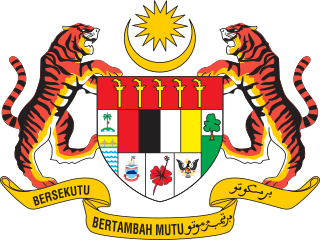
This article lists important figures and events in Malayan and Malaysian public affairs during the year 1963, together with births and deaths of significant Malaysians. The Federation of Malaya merged with Singapore, North Borneo, and Sarawak to form the Federation of Malaysia on 16 September.

Bukit Kepong incident was an armed encounter in 1950 during the Malayan Emergency between the Federation of Malaya Police and the guerrillas of the Malayan National Liberation Army (MNLA), the armed wing of the Malayan Communist Party (MCP). This conflict took place in an area surrounding the Bukit Kepong police station in Bukit Kepong. The wooden station was located on the river banks of the Muar River, about 59 km from Muar town, Johor.
This article lists important figures and events in Malayan public affairs during the year 1959, together with births and deaths of significant Malayans.
This article lists important figures and events in Malayan public affairs during the year 1950, together with births and deaths of significant Malayans.

The Most Esteemed Order of the Defender of the Realm is a Malaysian federal award presented for meritorious service to the country. The Order Motto are 'Dipeliharakan Allah-Pangkuan Negara'.
The Most Esteemed Order of Loyalty to the Crown of Malaysia is a Malaysian federal award presented for meritorious service to the country and awarded by the sovereign.
This article lists important figures and events in Malayan public affairs during the year 1954, as well as births and deaths of significant Malayans.

The Marine Police Force, Royal Malaysia Police is the Marine Police division of the Royal Malaysia Police tasked with maintaining law and order and execute national security operations in the Malaysian Territorial Waters (MTW) and no boundaries till the high seas. The Marine Police Force serves under the control of the Malaysian Internal Security & Public Order (ISPO) Department with the role of safeguarding the security of Malaysian waters from any threats.

Battle of Semur River was an armed encounter which took place on 25 March 1950 between the Malay Regiment and the gunmens of Malayan Communist Party during the Malayan Emergency. Seventeen soldiers of the Malay Regiment, from 12th Platoon of Delta Company were killed by the rebels, and eight wounded. Twenty-nine communist insurgents were also killed by the Malayan soldiers.
This article lists important figures and events in Malayan public affairs during the year 1953, together with births and deaths of significant Malayans.
This article lists important figures and events in the public affairs of British Malaya during the year 1938, together with births and deaths of prominent Malayans.
Ismail Johari was the author of the Bukit Kepong novel published by Dewan Bahasa dan Pustaka (DBP) in 1990 and one of the main script writers of the Bukit Kepong film produced by Jins Shamsuddin in 1981, both of which were based on an actual armed incident that took place on 23 February 1950 between the Federation of Malaya Police and gunmen of the Malayan Communist Party during the Malayan Emergency. The Bukit Kepong novel was adopted as the Form 4 secondary school and Sijil Pelajaran Malaysia (SPM) educational teaching material.
The Distinguished Order of Meritorious Service is a Malaysian federal award presented for meritorious service to the country.
The Most Distinguished Order of Loyalty to the Royal Family of Malaysia is a Malaysian federal award presented for service and loyalty to the Crown, often to members of the armed forces, police and civil service.
The Most Illustrious Order of Sultan Ahmad Shah of Pahang is a knighthood order of the Sultanate of Pahang.
The Most Illustrious Order of the Perak State Crown is knighthood order of the Sultanate of Perak.
The Most Valliant Order of Taming Sari is knighthood order of the Sultanate of Perak.
The Exalted Order of Malacca is the third-highest state order of Malacca which is conferred by the Yang di-Pertua Negeri of Malacca. The order was constituted in 1978 by Yang di-Pertua Negeri Syed Zahiruddin along with the Premier and Exalted Order of Malacca.
The Order of Sultan Salahuddin Abdul Aziz Shah is an obsolete order of chivalry conferred by the Sultan of Selangor as a reward for general services to the sultan and state of Selangor during the reigning of the late Sultan Salahuddin Abdul Aziz Shah Al-Haj. It was established by the late Sultan on 30 September 1985 and it became obsolete following his demise on 21 November 2001. The order was awarded to high-ranking individuals who have contributed excellence to the Sultan of Selangor and His Majesty's Government.





